JEEP CHEROKEE 1994 Service Repair Manual
Manufacturer: JEEP, Model Year: 1994, Model line: CHEROKEE, Model: JEEP CHEROKEE 1994Pages: 1784, PDF Size: 77.09 MB
Page 1641 of 1784
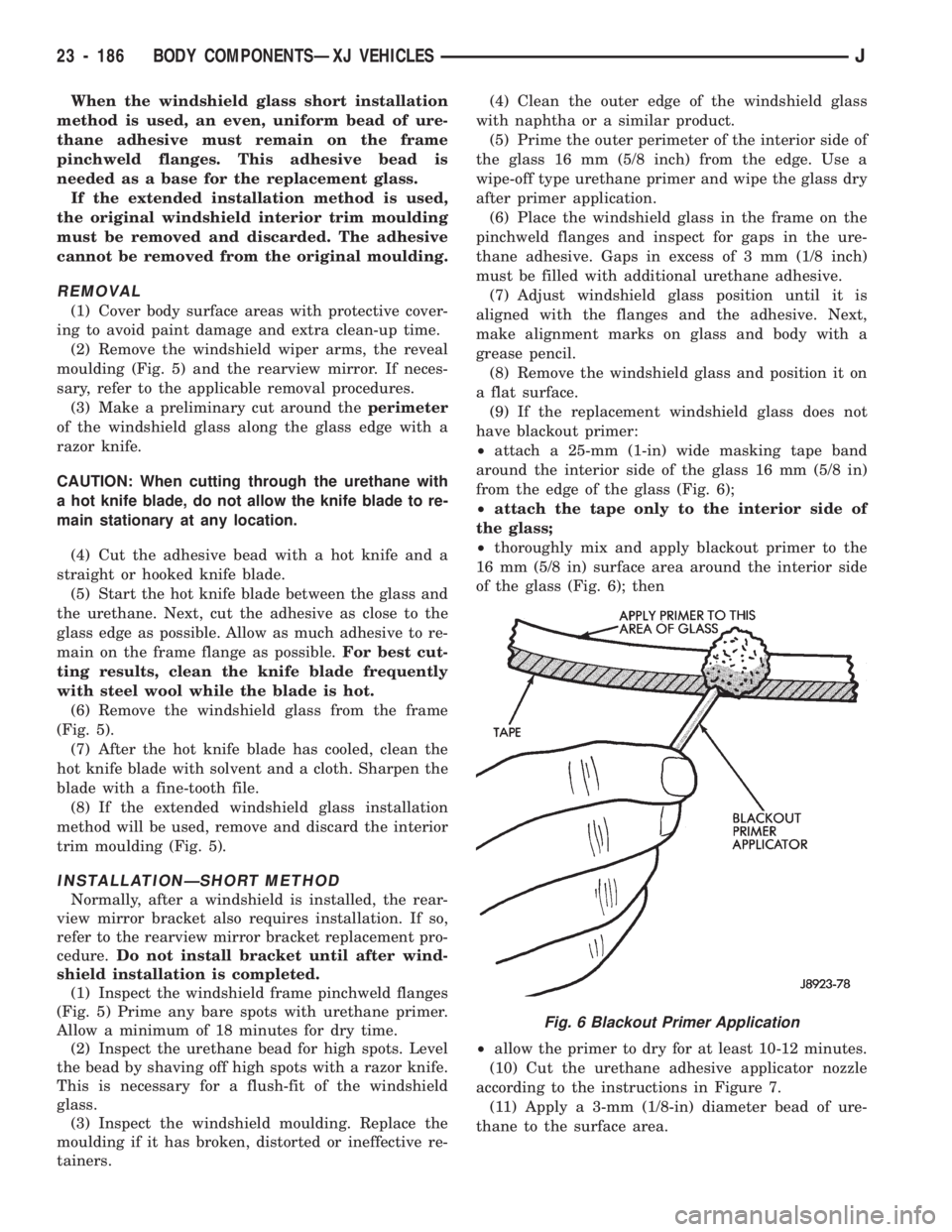
When the windshield glass short installation
method is used, an even, uniform bead of ure-
thane adhesive must remain on the frame
pinchweld flanges. This adhesive bead is
needed as a base for the replacement glass.
If the extended installation method is used,
the original windshield interior trim moulding
must be removed and discarded. The adhesive
cannot be removed from the original moulding.
REMOVAL
(1) Cover body surface areas with protective cover-
ing to avoid paint damage and extra clean-up time.
(2) Remove the windshield wiper arms, the reveal
moulding (Fig. 5) and the rearview mirror. If neces-
sary, refer to the applicable removal procedures.
(3) Make a preliminary cut around theperimeter
of the windshield glass along the glass edge with a
razor knife.
CAUTION: When cutting through the urethane with
a hot knife blade, do not allow the knife blade to re-
main stationary at any location.
(4) Cut the adhesive bead with a hot knife and a
straight or hooked knife blade.
(5) Start the hot knife blade between the glass and
the urethane. Next, cut the adhesive as close to the
glass edge as possible. Allow as much adhesive to re-
main on the frame flange as possible.For best cut-
ting results, clean the knife blade frequently
with steel wool while the blade is hot.
(6) Remove the windshield glass from the frame
(Fig. 5).
(7) After the hot knife blade has cooled, clean the
hot knife blade with solvent and a cloth. Sharpen the
blade with a fine-tooth file.
(8) If the extended windshield glass installation
method will be used, remove and discard the interior
trim moulding (Fig. 5).
INSTALLATIONÐSHORT METHOD
Normally, after a windshield is installed, the rear-
view mirror bracket also requires installation. If so,
refer to the rearview mirror bracket replacement pro-
cedure.Do not install bracket until after wind-
shield installation is completed.
(1) Inspect the windshield frame pinchweld flanges
(Fig. 5) Prime any bare spots with urethane primer.
Allow a minimum of 18 minutes for dry time.
(2) Inspect the urethane bead for high spots. Level
the bead by shaving off high spots with a razor knife.
This is necessary for a flush-fit of the windshield
glass.
(3) Inspect the windshield moulding. Replace the
moulding if it has broken, distorted or ineffective re-
tainers.(4) Clean the outer edge of the windshield glass
with naphtha or a similar product.
(5) Prime the outer perimeter of the interior side of
the glass 16 mm (5/8 inch) from the edge. Use a
wipe-off type urethane primer and wipe the glass dry
after primer application.
(6) Place the windshield glass in the frame on the
pinchweld flanges and inspect for gaps in the ure-
thane adhesive. Gaps in excess of 3 mm (1/8 inch)
must be filled with additional urethane adhesive.
(7) Adjust windshield glass position until it is
aligned with the flanges and the adhesive. Next,
make alignment marks on glass and body with a
grease pencil.
(8) Remove the windshield glass and position it on
a flat surface.
(9) If the replacement windshield glass does not
have blackout primer:
²attach a 25-mm (1-in) wide masking tape band
around the interior side of the glass 16 mm (5/8 in)
from the edge of the glass (Fig. 6);
²attach the tape only to the interior side of
the glass;
²thoroughly mix and apply blackout primer to the
16 mm (5/8 in) surface area around the interior side
of the glass (Fig. 6); then
²allow the primer to dry for at least 10-12 minutes.
(10) Cut the urethane adhesive applicator nozzle
according to the instructions in Figure 7.
(11) Apply a 3-mm (1/8-in) diameter bead of ure-
thane to the surface area.
Fig. 6 Blackout Primer Application
23 - 186 BODY COMPONENTSÐXJ VEHICLESJ
Page 1642 of 1784
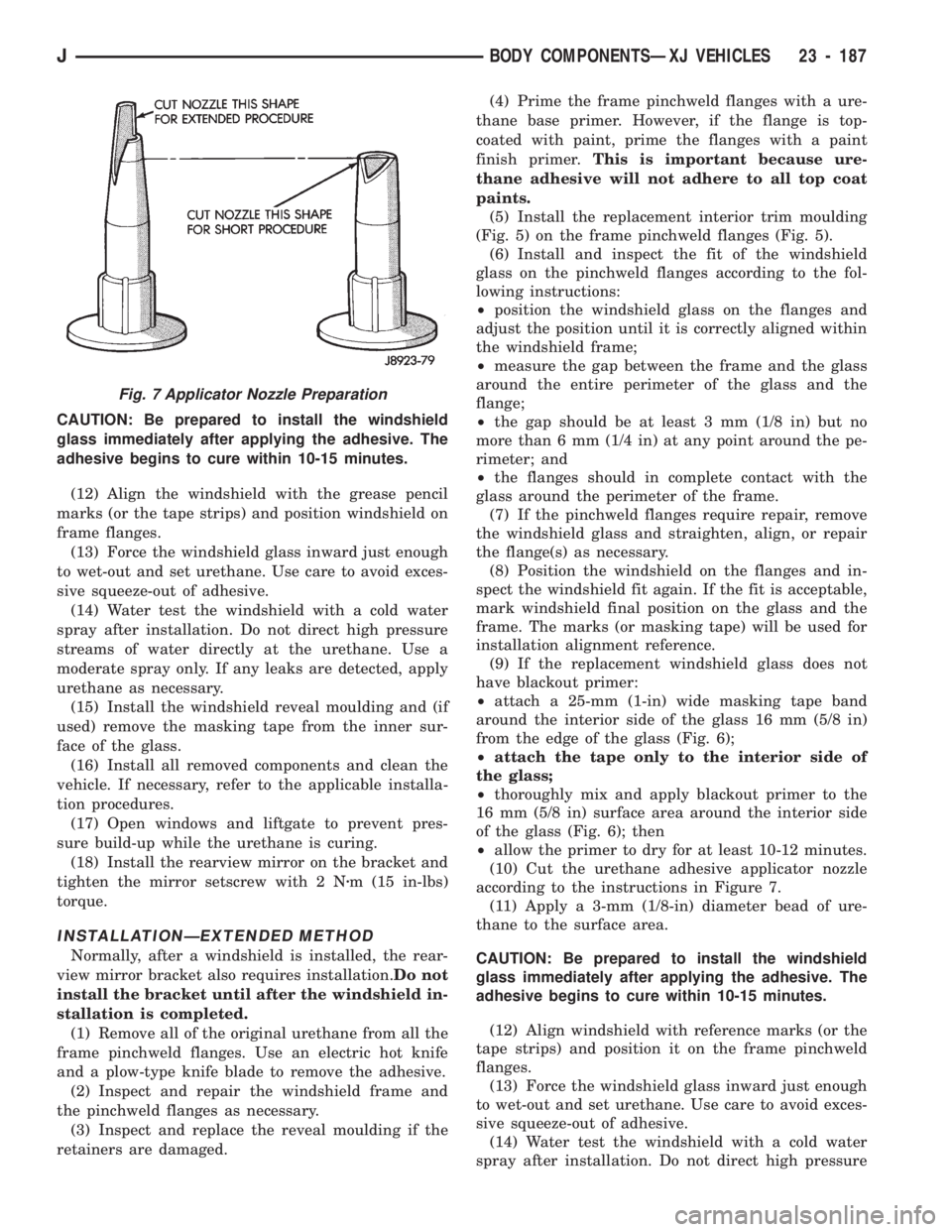
CAUTION: Be prepared to install the windshield
glass immediately after applying the adhesive. The
adhesive begins to cure within 10-15 minutes.
(12) Align the windshield with the grease pencil
marks (or the tape strips) and position windshield on
frame flanges.
(13) Force the windshield glass inward just enough
to wet-out and set urethane. Use care to avoid exces-
sive squeeze-out of adhesive.
(14) Water test the windshield with a cold water
spray after installation. Do not direct high pressure
streams of water directly at the urethane. Use a
moderate spray only. If any leaks are detected, apply
urethane as necessary.
(15) Install the windshield reveal moulding and (if
used) remove the masking tape from the inner sur-
face of the glass.
(16) Install all removed components and clean the
vehicle. If necessary, refer to the applicable installa-
tion procedures.
(17) Open windows and liftgate to prevent pres-
sure build-up while the urethane is curing.
(18) Install the rearview mirror on the bracket and
tighten the mirror setscrew with 2 Nzm (15 in-lbs)
torque.
INSTALLATIONÐEXTENDED METHOD
Normally, after a windshield is installed, the rear-
view mirror bracket also requires installation.Do not
install the bracket until after the windshield in-
stallation is completed.
(1) Remove all of the original urethane from all the
frame pinchweld flanges. Use an electric hot knife
and a plow-type knife blade to remove the adhesive.
(2) Inspect and repair the windshield frame and
the pinchweld flanges as necessary.
(3) Inspect and replace the reveal moulding if the
retainers are damaged.(4) Prime the frame pinchweld flanges with a ure-
thane base primer. However, if the flange is top-
coated with paint, prime the flanges with a paint
finish primer.This is important because ure-
thane adhesive will not adhere to all top coat
paints.
(5) Install the replacement interior trim moulding
(Fig. 5) on the frame pinchweld flanges (Fig. 5).
(6) Install and inspect the fit of the windshield
glass on the pinchweld flanges according to the fol-
lowing instructions:
²position the windshield glass on the flanges and
adjust the position until it is correctly aligned within
the windshield frame;
²measure the gap between the frame and the glass
around the entire perimeter of the glass and the
flange;
²the gap should be at least 3 mm (1/8 in) but no
more than 6 mm (1/4 in) at any point around the pe-
rimeter; and
²the flanges should in complete contact with the
glass around the perimeter of the frame.
(7) If the pinchweld flanges require repair, remove
the windshield glass and straighten, align, or repair
the flange(s) as necessary.
(8) Position the windshield on the flanges and in-
spect the windshield fit again. If the fit is acceptable,
mark windshield final position on the glass and the
frame. The marks (or masking tape) will be used for
installation alignment reference.
(9) If the replacement windshield glass does not
have blackout primer:
²attach a 25-mm (1-in) wide masking tape band
around the interior side of the glass 16 mm (5/8 in)
from the edge of the glass (Fig. 6);
²attach the tape only to the interior side of
the glass;
²thoroughly mix and apply blackout primer to the
16 mm (5/8 in) surface area around the interior side
of the glass (Fig. 6); then
²allow the primer to dry for at least 10-12 minutes.
(10) Cut the urethane adhesive applicator nozzle
according to the instructions in Figure 7.
(11) Apply a 3-mm (1/8-in) diameter bead of ure-
thane to the surface area.
CAUTION: Be prepared to install the windshield
glass immediately after applying the adhesive. The
adhesive begins to cure within 10-15 minutes.
(12) Align windshield with reference marks (or the
tape strips) and position it on the frame pinchweld
flanges.
(13) Force the windshield glass inward just enough
to wet-out and set urethane. Use care to avoid exces-
sive squeeze-out of adhesive.
(14) Water test the windshield with a cold water
spray after installation. Do not direct high pressure
Fig. 7 Applicator Nozzle Preparation
JBODY COMPONENTSÐXJ VEHICLES 23 - 187
Page 1643 of 1784
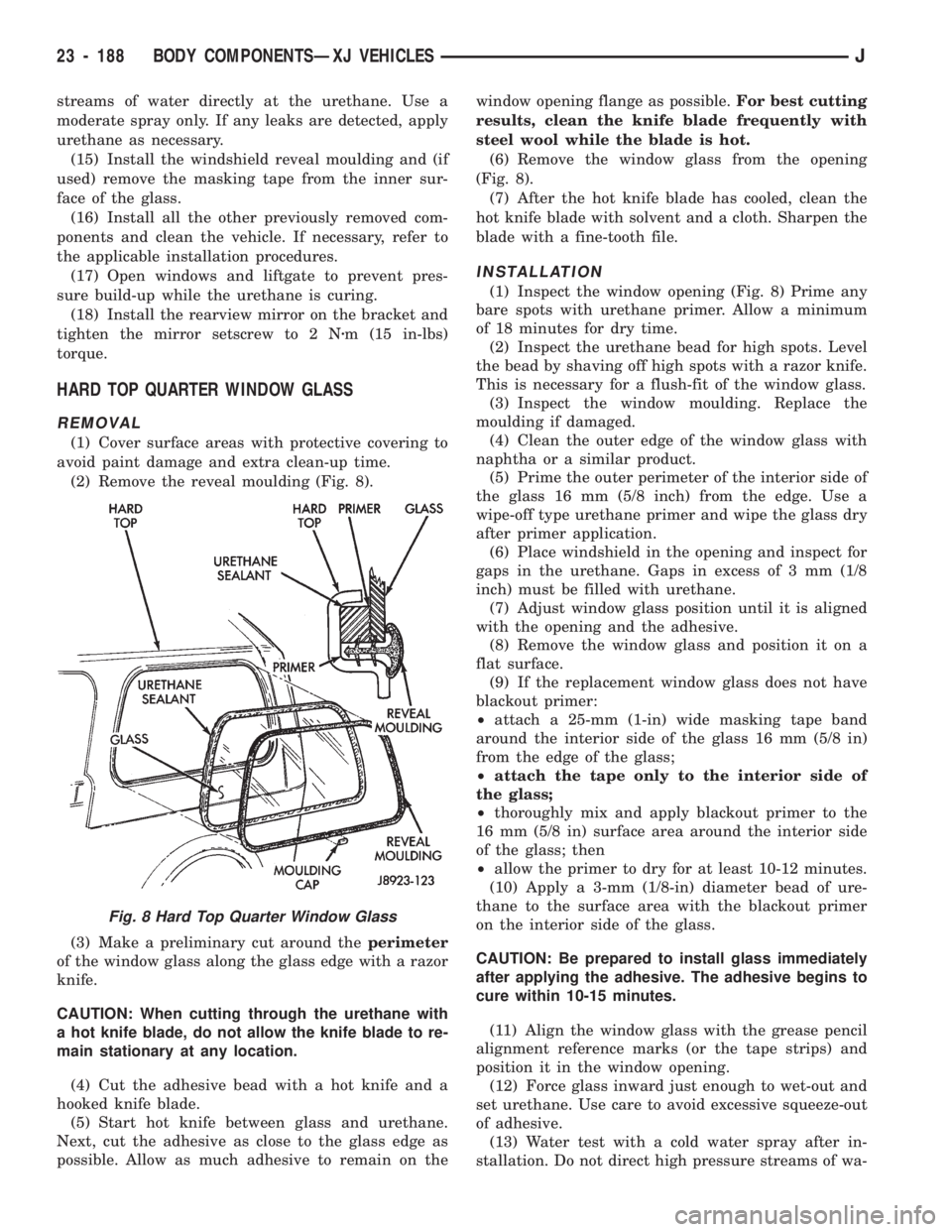
streams of water directly at the urethane. Use a
moderate spray only. If any leaks are detected, apply
urethane as necessary.
(15) Install the windshield reveal moulding and (if
used) remove the masking tape from the inner sur-
face of the glass.
(16) Install all the other previously removed com-
ponents and clean the vehicle. If necessary, refer to
the applicable installation procedures.
(17) Open windows and liftgate to prevent pres-
sure build-up while the urethane is curing.
(18) Install the rearview mirror on the bracket and
tighten the mirror setscrew to 2 Nzm (15 in-lbs)
torque.
HARD TOP QUARTER WINDOW GLASS
REMOVAL
(1) Cover surface areas with protective covering to
avoid paint damage and extra clean-up time.
(2) Remove the reveal moulding (Fig. 8).
(3) Make a preliminary cut around theperimeter
of the window glass along the glass edge with a razor
knife.
CAUTION: When cutting through the urethane with
a hot knife blade, do not allow the knife blade to re-
main stationary at any location.
(4) Cut the adhesive bead with a hot knife and a
hooked knife blade.
(5) Start hot knife between glass and urethane.
Next, cut the adhesive as close to the glass edge as
possible. Allow as much adhesive to remain on thewindow opening flange as possible.For best cutting
results, clean the knife blade frequently with
steel wool while the blade is hot.
(6) Remove the window glass from the opening
(Fig. 8).
(7) After the hot knife blade has cooled, clean the
hot knife blade with solvent and a cloth. Sharpen the
blade with a fine-tooth file.
INSTALLATION
(1) Inspect the window opening (Fig. 8) Prime any
bare spots with urethane primer. Allow a minimum
of 18 minutes for dry time.
(2) Inspect the urethane bead for high spots. Level
the bead by shaving off high spots with a razor knife.
This is necessary for a flush-fit of the window glass.
(3) Inspect the window moulding. Replace the
moulding if damaged.
(4) Clean the outer edge of the window glass with
naphtha or a similar product.
(5) Prime the outer perimeter of the interior side of
the glass 16 mm (5/8 inch) from the edge. Use a
wipe-off type urethane primer and wipe the glass dry
after primer application.
(6) Place windshield in the opening and inspect for
gaps in the urethane. Gaps in excess of 3 mm (1/8
inch) must be filled with urethane.
(7) Adjust window glass position until it is aligned
with the opening and the adhesive.
(8) Remove the window glass and position it on a
flat surface.
(9) If the replacement window glass does not have
blackout primer:
²attach a 25-mm (1-in) wide masking tape band
around the interior side of the glass 16 mm (5/8 in)
from the edge of the glass;
²attach the tape only to the interior side of
the glass;
²thoroughly mix and apply blackout primer to the
16 mm (5/8 in) surface area around the interior side
of the glass; then
²allow the primer to dry for at least 10-12 minutes.
(10) Apply a 3-mm (1/8-in) diameter bead of ure-
thane to the surface area with the blackout primer
on the interior side of the glass.
CAUTION: Be prepared to install glass immediately
after applying the adhesive. The adhesive begins to
cure within 10-15 minutes.
(11) Align the window glass with the grease pencil
alignment reference marks (or the tape strips) and
position it in the window opening.
(12) Force glass inward just enough to wet-out and
set urethane. Use care to avoid excessive squeeze-out
of adhesive.
(13) Water test with a cold water spray after in-
stallation. Do not direct high pressure streams of wa-
Fig. 8 Hard Top Quarter Window Glass
23 - 188 BODY COMPONENTSÐXJ VEHICLESJ
Page 1644 of 1784
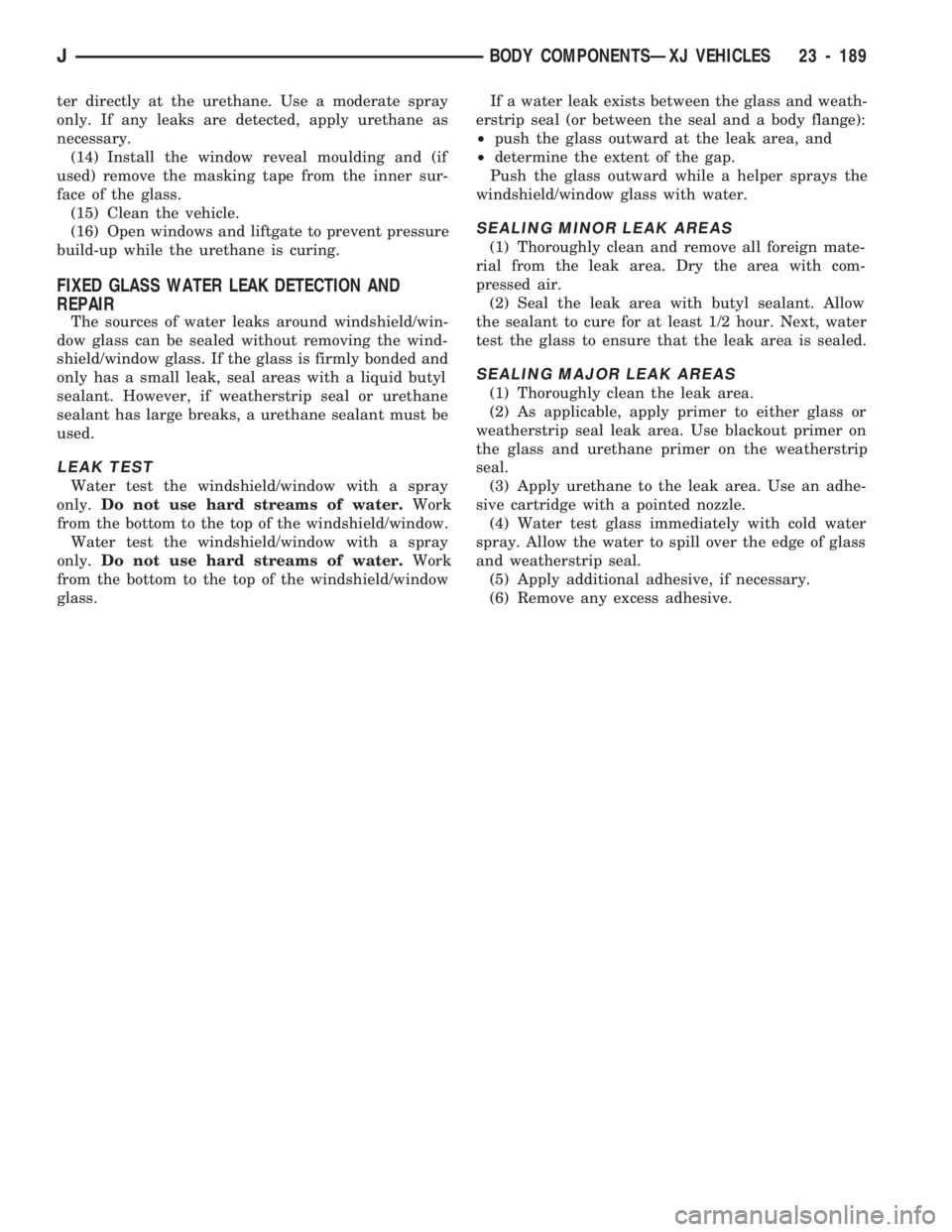
ter directly at the urethane. Use a moderate spray
only. If any leaks are detected, apply urethane as
necessary.
(14) Install the window reveal moulding and (if
used) remove the masking tape from the inner sur-
face of the glass.
(15) Clean the vehicle.
(16) Open windows and liftgate to prevent pressure
build-up while the urethane is curing.
FIXED GLASS WATER LEAK DETECTION AND
REPAIR
The sources of water leaks around windshield/win-
dow glass can be sealed without removing the wind-
shield/window glass. If the glass is firmly bonded and
only has a small leak, seal areas with a liquid butyl
sealant. However, if weatherstrip seal or urethane
sealant has large breaks, a urethane sealant must be
used.
LEAK TEST
Water test the windshield/window with a spray
only.Do not use hard streams of water.Work
from the bottom to the top of the windshield/window.
Water test the windshield/window with a spray
only.Do not use hard streams of water.Work
from the bottom to the top of the windshield/window
glass.If a water leak exists between the glass and weath-
erstrip seal (or between the seal and a body flange):
²push the glass outward at the leak area, and
²determine the extent of the gap.
Push the glass outward while a helper sprays the
windshield/window glass with water.
SEALING MINOR LEAK AREAS
(1) Thoroughly clean and remove all foreign mate-
rial from the leak area. Dry the area with com-
pressed air.
(2) Seal the leak area with butyl sealant. Allow
the sealant to cure for at least 1/2 hour. Next, water
test the glass to ensure that the leak area is sealed.
SEALING MAJOR LEAK AREAS
(1) Thoroughly clean the leak area.
(2) As applicable, apply primer to either glass or
weatherstrip seal leak area. Use blackout primer on
the glass and urethane primer on the weatherstrip
seal.
(3) Apply urethane to the leak area. Use an adhe-
sive cartridge with a pointed nozzle.
(4) Water test glass immediately with cold water
spray. Allow the water to spill over the edge of glass
and weatherstrip seal.
(5) Apply additional adhesive, if necessary.
(6) Remove any excess adhesive.
JBODY COMPONENTSÐXJ VEHICLES 23 - 189
Page 1645 of 1784

INTERIOR COMPONENTS
INDEX
page page
Carpet/Floor Mats....................... 198
Floor Consoles......................... 197
Front Shoulder Belts..................... 196
Glove Box............................. 194
Instrument Cluster and Gauge Housings...... 190
Instrument Cluster Bezel.................. 191Instrument Panel........................ 190
Instrument Panel Components.............. 191
Instrument Panel Service.................. 192
Rear Shoulder Belts..................... 196
Seats................................ 195
Sunvisors............................. 196
INSTRUMENT PANEL
SERVICE INFORMATION
The instrument panel is constructed of sheet metal
and is attached to cowl panel with screws. The in-
strument panel and defroster grille pad is attached
to the instrument panel with screws.
INSTRUMENT CLUSTER AND GAUGE HOUSINGS
REMOVAL
(1) Remove the instrument cluster and gauge
housing attaching screws (Figs. 1, 2 and 3).
(2) Disconnect the switch illumination bulb socket
from the instrument cluster housing (Fig. 4). Remove
the housings from the instrument panel (Fig. 1).
INSTALLATION
(1) Position the instrument cluster and gauge
housings on the instrument panel (Fig. 1). Connect
the switch illumination bulb socket to the instrument
cluster housing (Fig. 4).
(2) Install the attaching screws (Figs. 1, 2 and 3).
Tighten the screws to 3 Nzm (24 in-lbs) torque.
Fig. 2 Instrument Cluster Housing Lower Screws
Fig. 3 Instrument Gauge Housing Screws
Fig. 1 Instrument Cluster/Gauge Housing and Radio
23 - 190 BODY COMPONENTSÐXJ VEHICLESJ
Page 1646 of 1784
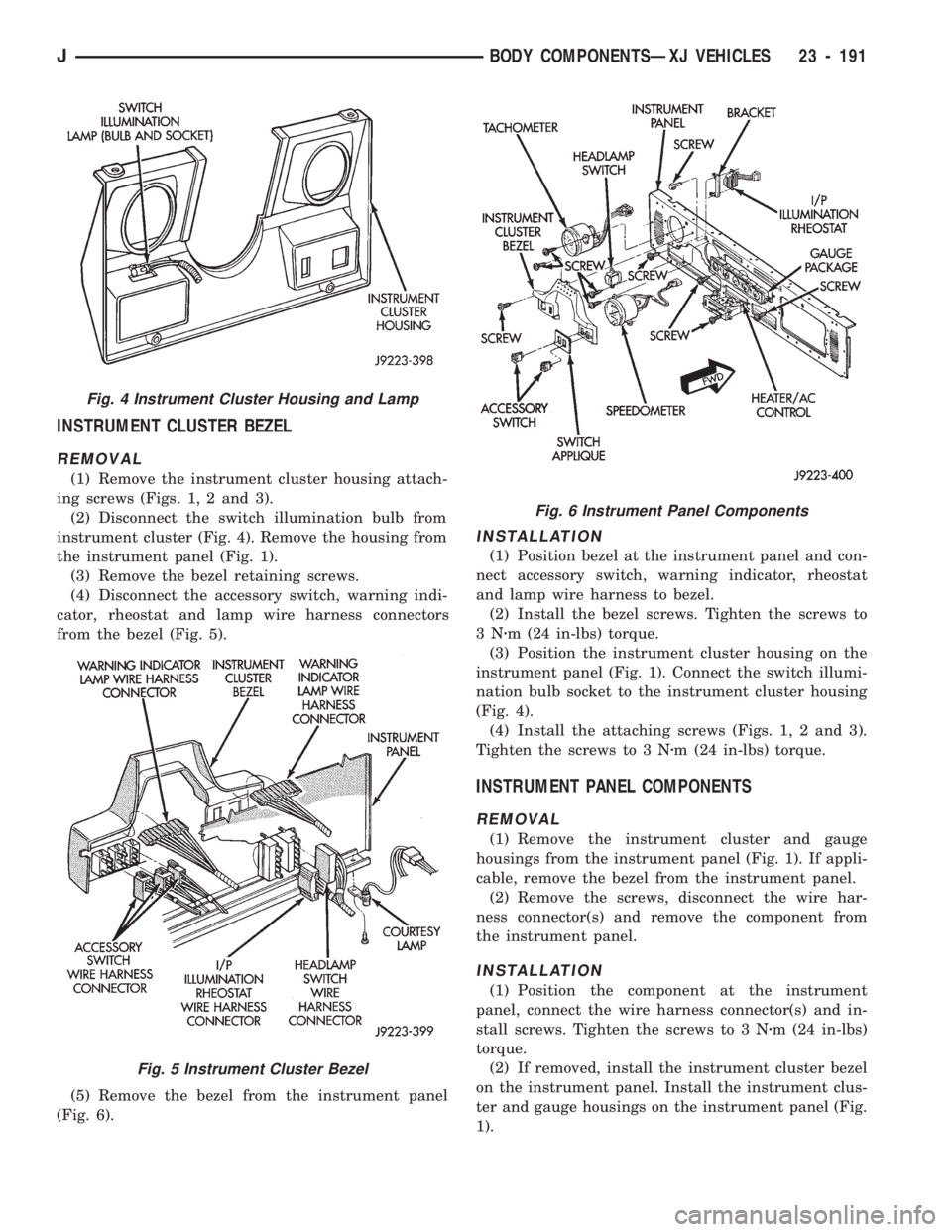
INSTRUMENT CLUSTER BEZEL
REMOVAL
(1) Remove the instrument cluster housing attach-
ing screws (Figs. 1, 2 and 3).
(2) Disconnect the switch illumination bulb from
instrument cluster (Fig. 4). Remove the housing from
the instrument panel (Fig. 1).
(3) Remove the bezel retaining screws.
(4) Disconnect the accessory switch, warning indi-
cator, rheostat and lamp wire harness connectors
from the bezel (Fig. 5).
(5) Remove the bezel from the instrument panel
(Fig. 6).
INSTALLATION
(1) Position bezel at the instrument panel and con-
nect accessory switch, warning indicator, rheostat
and lamp wire harness to bezel.
(2) Install the bezel screws. Tighten the screws to
3Nzm (24 in-lbs) torque.
(3) Position the instrument cluster housing on the
instrument panel (Fig. 1). Connect the switch illumi-
nation bulb socket to the instrument cluster housing
(Fig. 4).
(4) Install the attaching screws (Figs. 1, 2 and 3).
Tighten the screws to 3 Nzm (24 in-lbs) torque.
INSTRUMENT PANEL COMPONENTS
REMOVAL
(1) Remove the instrument cluster and gauge
housings from the instrument panel (Fig. 1). If appli-
cable, remove the bezel from the instrument panel.
(2) Remove the screws, disconnect the wire har-
ness connector(s) and remove the component from
the instrument panel.
INSTALLATION
(1) Position the component at the instrument
panel, connect the wire harness connector(s) and in-
stall screws. Tighten the screws to 3 Nzm (24 in-lbs)
torque.
(2) If removed, install the instrument cluster bezel
on the instrument panel. Install the instrument clus-
ter and gauge housings on the instrument panel (Fig.
1).
Fig. 4 Instrument Cluster Housing and Lamp
Fig. 5 Instrument Cluster Bezel
Fig. 6 Instrument Panel Components
JBODY COMPONENTSÐXJ VEHICLES 23 - 191
Page 1647 of 1784
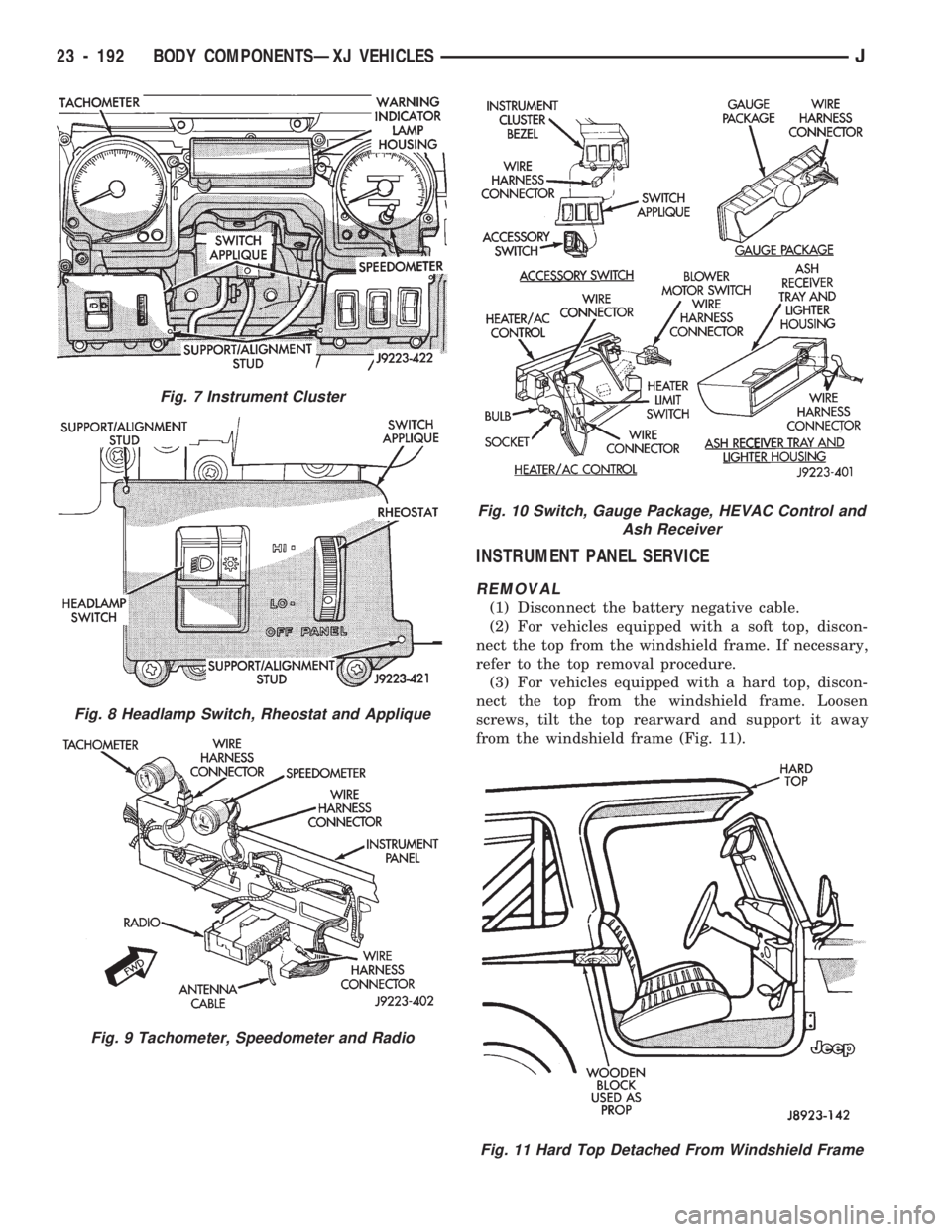
INSTRUMENT PANEL SERVICE
REMOVAL
(1) Disconnect the battery negative cable.
(2) For vehicles equipped with a soft top, discon-
nect the top from the windshield frame. If necessary,
refer to the top removal procedure.
(3) For vehicles equipped with a hard top, discon-
nect the top from the windshield frame. Loosen
screws, tilt the top rearward and support it away
from the windshield frame (Fig. 11).
Fig. 7 Instrument Cluster
Fig. 8 Headlamp Switch, Rheostat and Applique
Fig. 9 Tachometer, Speedometer and Radio
Fig. 10 Switch, Gauge Package, HEVAC Control and
Ash Receiver
Fig. 11 Hard Top Detached From Windshield Frame
23 - 192 BODY COMPONENTSÐXJ VEHICLESJ
Page 1648 of 1784
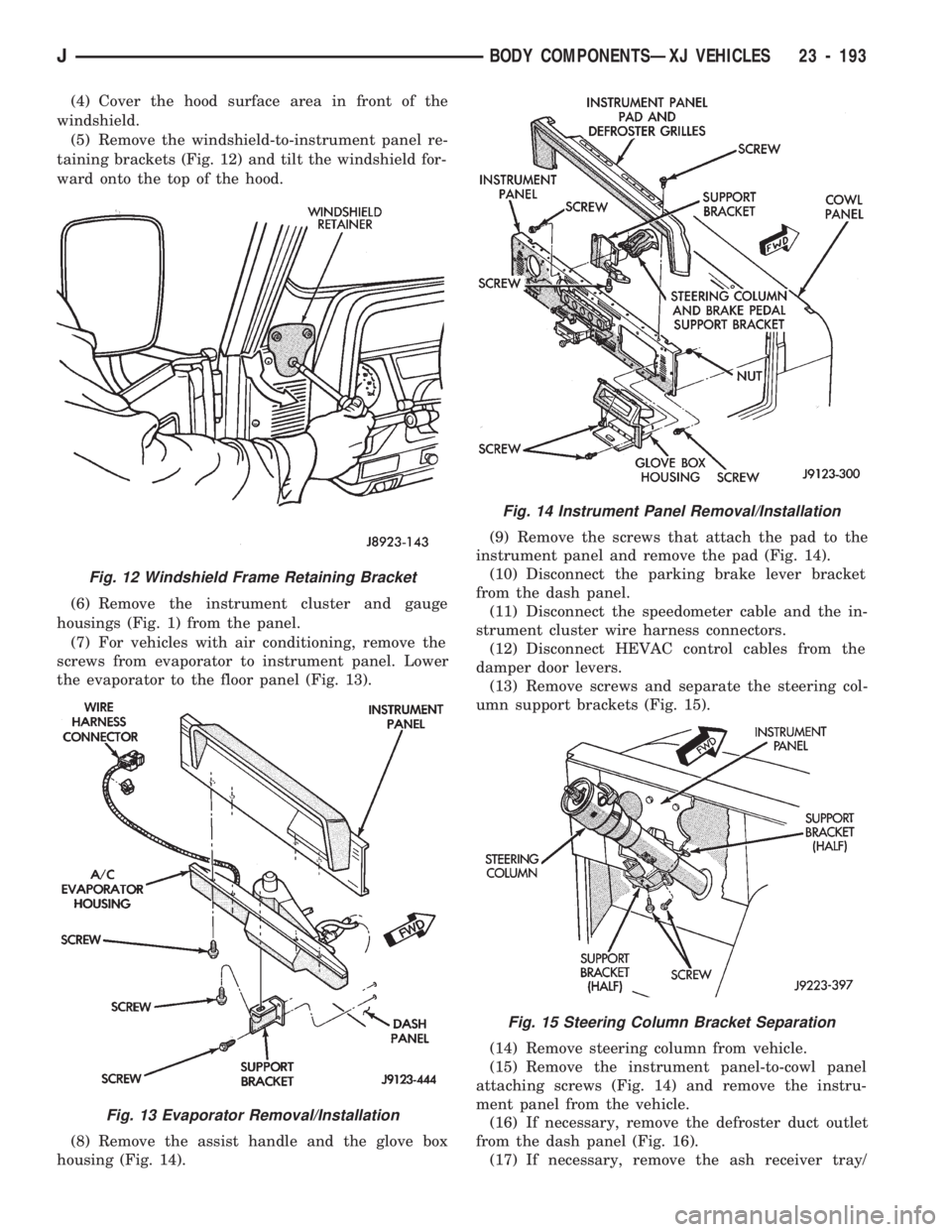
(4) Cover the hood surface area in front of the
windshield.
(5) Remove the windshield-to-instrument panel re-
taining brackets (Fig. 12) and tilt the windshield for-
ward onto the top of the hood.
(6) Remove the instrument cluster and gauge
housings (Fig. 1) from the panel.
(7) For vehicles with air conditioning, remove the
screws from evaporator to instrument panel. Lower
the evaporator to the floor panel (Fig. 13).
(8) Remove the assist handle and the glove box
housing (Fig. 14).(9) Remove the screws that attach the pad to the
instrument panel and remove the pad (Fig. 14).
(10) Disconnect the parking brake lever bracket
from the dash panel.
(11) Disconnect the speedometer cable and the in-
strument cluster wire harness connectors.
(12) Disconnect HEVAC control cables from the
damper door levers.
(13) Remove screws and separate the steering col-
umn support brackets (Fig. 15).
(14) Remove steering column from vehicle.
(15) Remove the instrument panel-to-cowl panel
attaching screws (Fig. 14) and remove the instru-
ment panel from the vehicle.
(16) If necessary, remove the defroster duct outlet
from the dash panel (Fig. 16).
(17) If necessary, remove the ash receiver tray/
Fig. 12 Windshield Frame Retaining Bracket
Fig. 13 Evaporator Removal/Installation
Fig. 14 Instrument Panel Removal/Installation
Fig. 15 Steering Column Bracket Separation
JBODY COMPONENTSÐXJ VEHICLES 23 - 193
Page 1649 of 1784
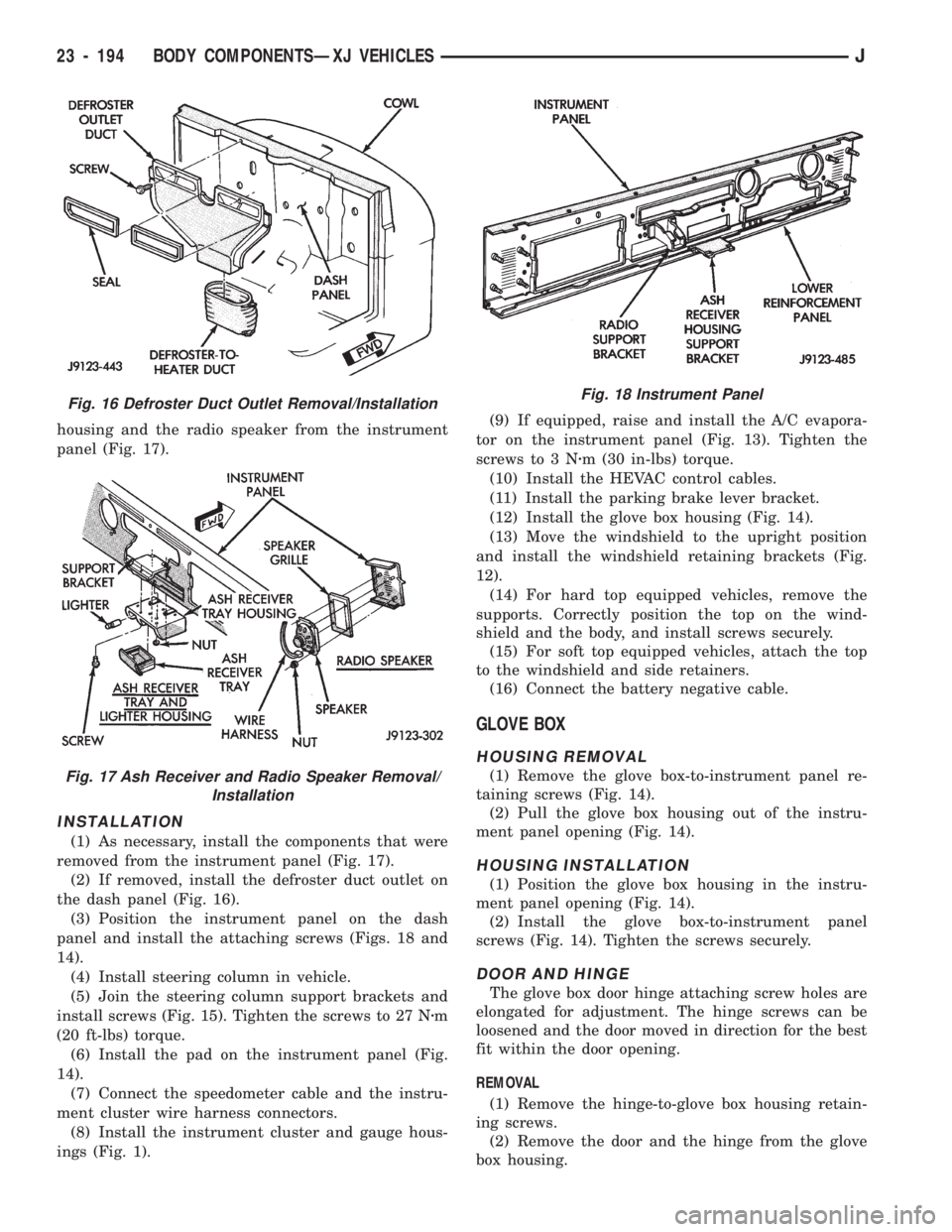
housing and the radio speaker from the instrument
panel (Fig. 17).
INSTALLATION
(1) As necessary, install the components that were
removed from the instrument panel (Fig. 17).
(2) If removed, install the defroster duct outlet on
the dash panel (Fig. 16).
(3) Position the instrument panel on the dash
panel and install the attaching screws (Figs. 18 and
14).
(4) Install steering column in vehicle.
(5) Join the steering column support brackets and
install screws (Fig. 15). Tighten the screws to 27 Nzm
(20 ft-lbs) torque.
(6) Install the pad on the instrument panel (Fig.
14).
(7) Connect the speedometer cable and the instru-
ment cluster wire harness connectors.
(8) Install the instrument cluster and gauge hous-
ings (Fig. 1).(9) If equipped, raise and install the A/C evapora-
tor on the instrument panel (Fig. 13). Tighten the
screws to 3 Nzm (30 in-lbs) torque.
(10) Install the HEVAC control cables.
(11) Install the parking brake lever bracket.
(12) Install the glove box housing (Fig. 14).
(13) Move the windshield to the upright position
and install the windshield retaining brackets (Fig.
12).
(14) For hard top equipped vehicles, remove the
supports. Correctly position the top on the wind-
shield and the body, and install screws securely.
(15) For soft top equipped vehicles, attach the top
to the windshield and side retainers.
(16) Connect the battery negative cable.
GLOVE BOX
HOUSING REMOVAL
(1) Remove the glove box-to-instrument panel re-
taining screws (Fig. 14).
(2) Pull the glove box housing out of the instru-
ment panel opening (Fig. 14).
HOUSING INSTALLATION
(1) Position the glove box housing in the instru-
ment panel opening (Fig. 14).
(2) Install the glove box-to-instrument panel
screws (Fig. 14). Tighten the screws securely.
DOOR AND HINGE
The glove box door hinge attaching screw holes are
elongated for adjustment. The hinge screws can be
loosened and the door moved in direction for the best
fit within the door opening.
REMOVAL
(1) Remove the hinge-to-glove box housing retain-
ing screws.
(2) Remove the door and the hinge from the glove
box housing.
Fig. 16 Defroster Duct Outlet Removal/Installation
Fig. 17 Ash Receiver and Radio Speaker Removal/
Installation
Fig. 18 Instrument Panel
23 - 194 BODY COMPONENTSÐXJ VEHICLESJ
Page 1650 of 1784
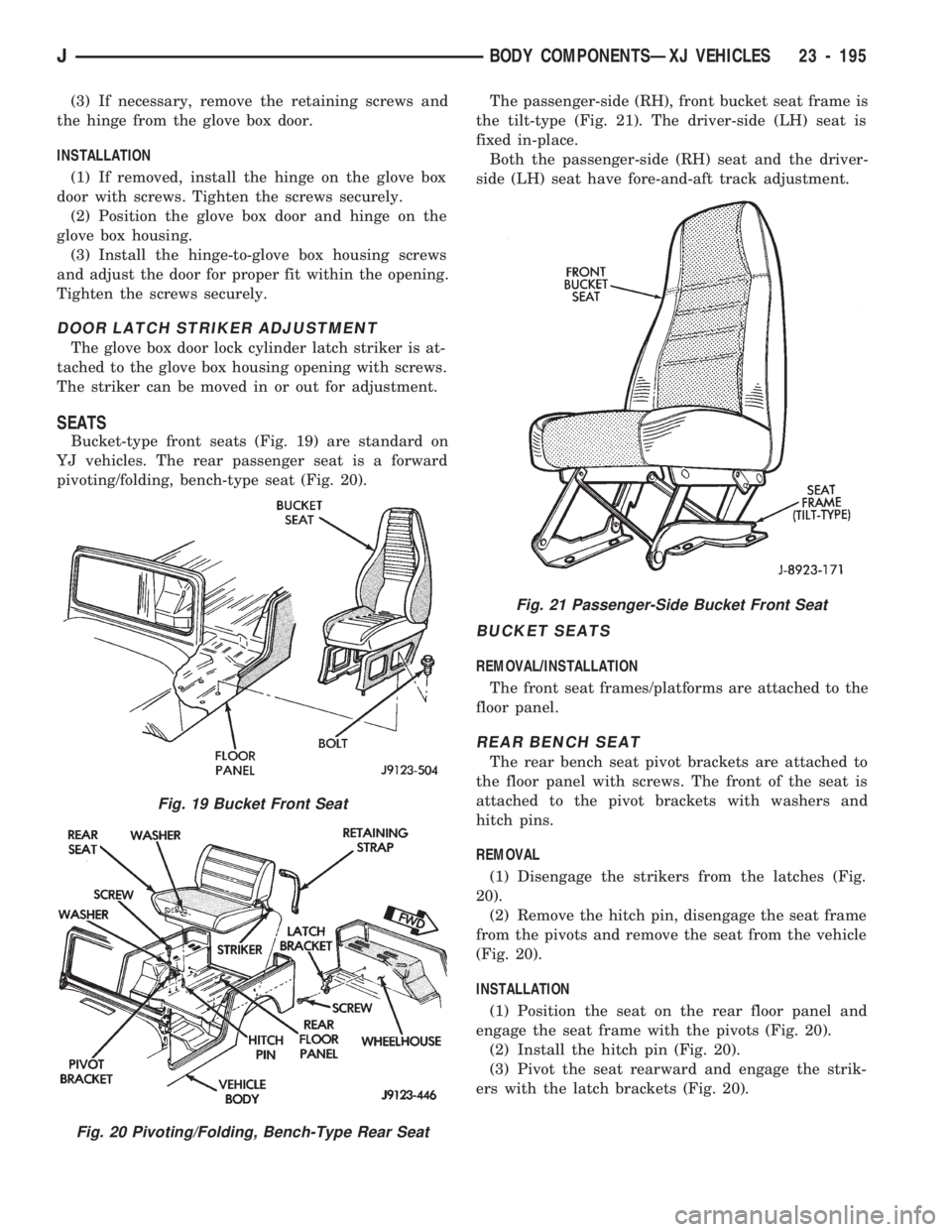
(3) If necessary, remove the retaining screws and
the hinge from the glove box door.
INSTALLATION
(1) If removed, install the hinge on the glove box
door with screws. Tighten the screws securely.
(2) Position the glove box door and hinge on the
glove box housing.
(3) Install the hinge-to-glove box housing screws
and adjust the door for proper fit within the opening.
Tighten the screws securely.
DOOR LATCH STRIKER ADJUSTMENT
The glove box door lock cylinder latch striker is at-
tached to the glove box housing opening with screws.
The striker can be moved in or out for adjustment.
SEATS
Bucket-type front seats (Fig. 19) are standard on
YJ vehicles. The rear passenger seat is a forward
pivoting/folding, bench-type seat (Fig. 20).The passenger-side (RH), front bucket seat frame is
the tilt-type (Fig. 21). The driver-side (LH) seat is
fixed in-place.
Both the passenger-side (RH) seat and the driver-
side (LH) seat have fore-and-aft track adjustment.
BUCKET SEATS
REMOVAL/INSTALLATION
The front seat frames/platforms are attached to the
floor panel.
REAR BENCH SEAT
The rear bench seat pivot brackets are attached to
the floor panel with screws. The front of the seat is
attached to the pivot brackets with washers and
hitch pins.
REMOVAL
(1) Disengage the strikers from the latches (Fig.
20).
(2) Remove the hitch pin, disengage the seat frame
from the pivots and remove the seat from the vehicle
(Fig. 20).
INSTALLATION
(1) Position the seat on the rear floor panel and
engage the seat frame with the pivots (Fig. 20).
(2) Install the hitch pin (Fig. 20).
(3) Pivot the seat rearward and engage the strik-
ers with the latch brackets (Fig. 20).
Fig. 19 Bucket Front Seat
Fig. 20 Pivoting/Folding, Bench-Type Rear Seat
Fig. 21 Passenger-Side Bucket Front Seat
JBODY COMPONENTSÐXJ VEHICLES 23 - 195